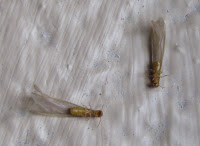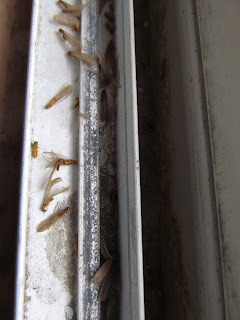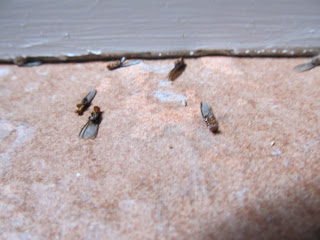2012 Arizona Termites Swarm Season underway!
Metro Phoenix area homeowners are reporting large swarms of winged
Arizona termites in and around their homes as recent monsoon rains have kicked
off the 2012 swarm season.
Native Subterranean termites (Heterotermes) are the most common
and destructive species of termites found in the Phoenix area. Heterotermes in Arizona are notorious for
attacking homes, wood utility poles, wood structures and creating millions of
dollars worth of damage yearly.
Native subterranean termites are usually 4-6 times smaller than
other species which give them a unique ability to enter a structure undetected via
small expansion joints and stress cracks.
While colonies tend to be smaller in size this species will often
co-exist with 10-15 other colonies on the same lot. Homes under attack by multiple colonies can be
damaged in a relatively short time.
Native subterranean
termites prefer to eat the soft wood of a two by four which contains the most
moisture and is easier to digest. Damaged wood appears honeycombed, with soil
in the galleries.
Native
subterranean termites are less dependent on moisture and decay than other
subterranean termites in Arizona. They will readily attack dry, sound wood. A
typical sign of infestation is the presence of drop tubes coming from the ceiling
joists and drywall, or shelter tubes appearing on the stem wall.
Native subterranean
termites prefer to forage in shaded soil and/or areas made wet by recent
rainfall.
They construct
mud shelter tubes up stem walls, over or around solid objects in order to reach
a food source. These mud-tubes are slender, solidly built and pale yellow to
tan in color. Darker soil usually indicates fresh tubes with a high moisture
content. As tubes age (dry out) they
become lighter in color and brittle.
The mud-tubes are
more circular in cross section than those of the other Arizona subterranean
termites whose mud-tubes are flattened in cross section and dirty light brown
in color.
Native
subterranean termites often swarm at night during the monsoon season, from July
to September, usually shortly after rain storms. The moist soil provides the
nuptial swarmers with the best chance of surviving and developing a new colony.
The male and female pair off and enter the soil where they excavate a cavity or
cell.
A well-developed
mature colony may contain more than 300,000 termites, including a large number
of secondary reproductives (queens) that can readily break off from the primary
colony to form separate colonies. Native subterranean termites commonly have a
foraging territory of up to almost an acre.
The first step in
protecting your home against termite destruction is to have a yearly termite inspection. If, and when termites invade
your home will be the time to consider a termite treatment.




